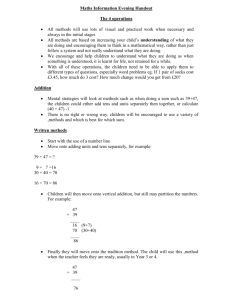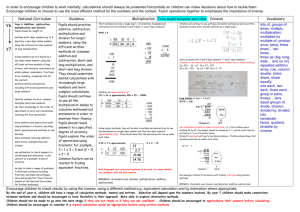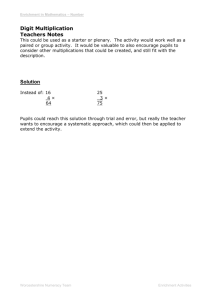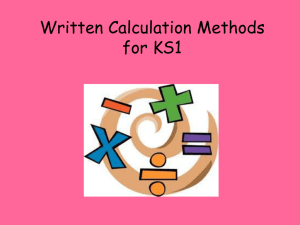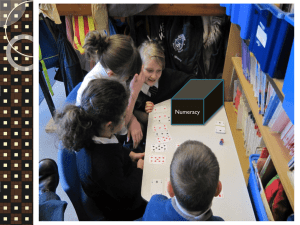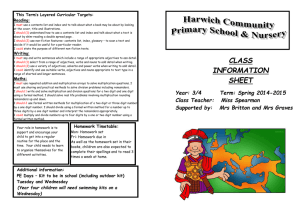EALC Yr6 Multiplication and Division
advertisement
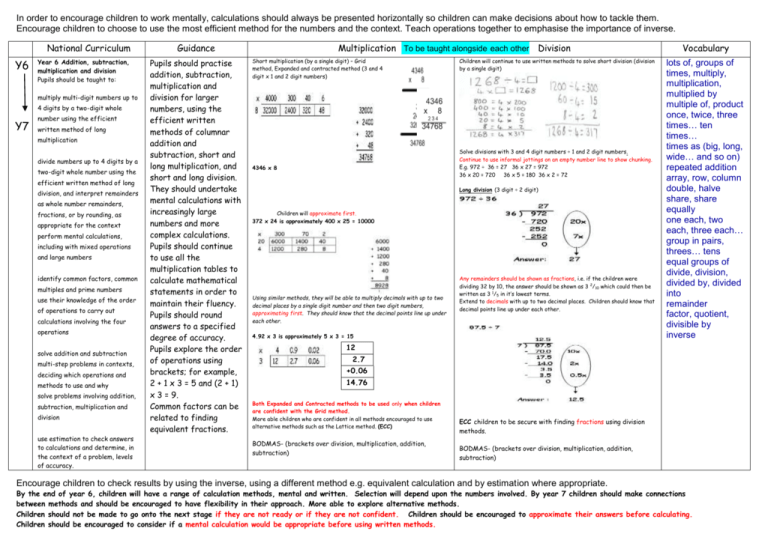
In order to encourage children to work mentally, calculations should always be presented horizontally so children can make decisions about how to tackle them. Encourage children to choose to use the most efficient method for the numbers and the context. Teach operations together to emphasise the importance of inverse. National Curriculum Y6 Year 6 Addition, subtraction, multiplication and division Pupils should be taught to: multiply multi-digit numbers up to 4 digits by a two-digit whole Y7 number using the efficient written method of long multiplication divide numbers up to 4 digits by a two-digit whole number using the efficient written method of long division, and interpret remainders as whole number remainders, fractions, or by rounding, as appropriate for the context perform mental calculations, including with mixed operations and large numbers identify common factors, common multiples and prime numbers use their knowledge of the order of operations to carry out calculations involving the four operations solve addition and subtraction multi-step problems in contexts, deciding which operations and methods to use and why solve problems involving addition, subtraction, multiplication and division use estimation to check answers to calculations and determine, in the context of a problem, levels of accuracy. Guidance Pupils should practise addition, subtraction, multiplication and division for larger numbers, using the efficient written methods of columnar addition and subtraction, short and long multiplication, and short and long division. They should undertake mental calculations with increasingly large numbers and more complex calculations. Pupils should continue to use all the multiplication tables to calculate mathematical statements in order to maintain their fluency. Pupils should round answers to a specified degree of accuracy. Pupils explore the order of operations using brackets; for example, 2 + 1 x 3 = 5 and (2 + 1) x 3 = 9. Common factors can be related to finding equivalent fractions. Multiplication To be taught alongside each other Division Short multiplication (by a single digit) – Grid method, Expanded and contracted method (3 and 4 digit x 1 and 2 digit numbers) Children will continue to use written methods to solve short division (division by a single digit) Solve divisions with 3 and 4 digit numbers ÷ 1 and 2 digit numbers. Continue to use informal jottings on an empty number line to show chunking. E.g. 972 ÷ 36 = 27 36 x 27 = 972 36 x 20 = 720 36 x 5 = 180 36 x 2 = 72 4346 x 8 Long division (3 digit ÷ 2 digit) Children will approximate first. 372 x 24 is approximately 400 x 25 = 10000 Using similar methods, they will be able to multiply decimals with up to two decimal places by a single digit number and then two digit numbers, approximating first. They should know that the decimal points line up under each other. Any remainders should be shown as fractions, i.e. if the children were dividing 32 by 10, the answer should be shown as 3 2/10 which could then be written as 3 1/5 in it’s lowest terms. Extend to decimals with up to two decimal places. Children should know that decimal points line up under each other. 4.92 x 3 is approximately 5 x 3 = 15 Vocabulary lots of, groups of times, multiply, multiplication, multiplied by multiple of, product once, twice, three times… ten times… times as (big, long, wide… and so on) repeated addition array, row, column double, halve share, share equally one each, two each, three each… group in pairs, threes… tens equal groups of divide, division, divided by, divided into remainder factor, quotient, divisible by inverse 12 2.7 +0.06 14.76 Both Expanded and Contracted methods to be used only when children are confident with the Grid method. More able children who are confident in all methods encouraged to use alternative methods such as the Lattice method. (ECC) BODMAS- (brackets over division, multiplication, addition, subtraction) ECC children to be secure with finding fractions using division methods. BODMAS- (brackets over division, multiplication, addition, subtraction) Encourage children to check results by using the inverse, using a different method e.g. equivalent calculation and by estimation where appropriate. By the end of year 6, children will have a range of calculation methods, mental and written. Selection will depend upon the numbers involved. By year 7 children should make connections between methods and should be encouraged to have flexibility in their approach. More able to explore alternative methods. Children should not be made to go onto the next stage if they are not ready or if they are not confident. Children should be encouraged to approximate their answers before calculating. Children should be encouraged to consider if a mental calculation would be appropriate before using written methods. In order to encourage children to work mentally, calculations should always be presented horizontally so children can make decisions about how to tackle them. Encourage children to choose to use the most efficient method for the numbers and the context. Teach operations together to emphasise the importance of inverse. Encourage children to check results by using the inverse, using a different method e.g. equivalent calculation and by estimation where appropriate. By the end of year 6, children will have a range of calculation methods, mental and written. Selection will depend upon the numbers involved. By year 7 children should make connections between methods and should be encouraged to have flexibility in their approach. More able to explore alternative methods. Children should not be made to go onto the next stage if they are not ready or if they are not confident. Children should be encouraged to approximate their answers before calculating. Children should be encouraged to consider if a mental calculation would be appropriate before using written methods.
